 W
WAmbassador is a United Kingdom tea clipper built in 1869. She was a composite clipper, built with wooden planking over an iron skeleton and was W. Lund & Co's first tea clipper. She is now a beached wreck in southern Chile.
 W
WAriel was a clipper ship famous for making fast voyages between China and England in the late 1860s. She is most famous for almost winning The Great Tea Race of 1866, an unofficial race between Foochow, China and London with the first tea crop of the 1866 season.
 W
WChallenger was a wooden clipper ship built in 1852 by Richard & Henry Green, in their Blackwall Yard for Hugh Hamilton Lindsay, London. She was the 291st ship built by the yard and was a remarkable departure from the previous ships produced. In 1850 the American clipper ship Oriental visited West India Docks, the largest clipper ship to visit London and the Admiralty was given permission to take her lines, and this was done by Messrs Waymouth and Cornish, both Lloyd's Surveyors, in the dry dock at Green's Yard in Blackwell. This is probably the reason that it was said that Challenger's design was inspired by and had a close resemblance to the Oriental's.
 W
WComet was an 1851 California clipper built by William H. Webb which sailed in the Australia trade and the tea trade. This extreme clipper was very fast. She had record passages on two different routes: New York City to San Francisco, and Liverpool to Hong Kong, and beat the famous clipper Flying Dutchman in an 1853 race around the Horn to San Francisco.
 W
WCutty Sark is a British clipper ship. Built on the River Leven, Dumbarton, Scotland in 1869 for the Jock Willis Shipping Line, she was one of the last tea clippers to be built and one of the fastest, coming at the end of a long period of design development for this type of vessel, which halted as steamships took over their routes.
 W
WFiery Cross was a famous British tea clipper which sailed in the Great Tea Race of 1866. She was the first ship home in the tea seasons of 1861, 1862, 1863, and 1865.
 W
WFusi Yama was a composite barque ship of roughly 556 tons, built in 1865 by Alexander Stephen & Sons at Glasgow for Killick Martin & Company, London.
 W
WHallowe’en was a 920-ton iron clipper ship. She was built in 1870 by Maudslay, Son & Field at Greenwich, England, for Jock Willis & Sons, and was a sister ship to the clipper ship Blackadder.
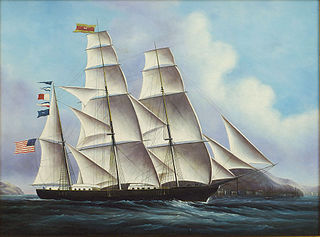 W
WHouqua was an early clipper ship with an innovative hull design, built for A.A. Low & Brother in 1844. She sailed in the China trade.
 W
WJohn C. Munro was an iron full-rigged ship built in 1862 by James Laing, Sunderland. Dimensions: 169"2'×28'2"×18'5" and tonnage: 612 tons.
 W
WKaisow, a composite clipper, was built by Robert Steele & Company at Greenock and launched on 19 November 1868.
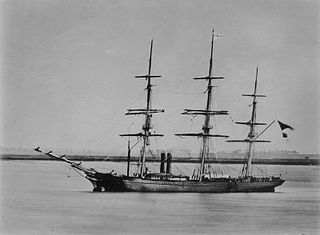 W
WLahloo was a British tea clipper known for winning the Tea Race of 1870, and finishing second in the Tea Race of 1871. She sailed from Foochow to London with over a million pounds of tea in 1868.
 W
WLammermuir, named for the Lammermuir Hills, was a tea clipper built in Sunderland by William Pile. She was the first clipper owned by Jock Willis Shipping Line. She was a fast sailer, being the second ship home in the 1858-59 tea season. She was a favourite of John Willis senior.
 W
WLeander was a composite built clipper ship. She was designed by Bernard Waymouth, and built in 1867 by J G Lawrie of Glasgow for Joseph Somes. She had a particularly extreme hull shape, with a coefficient of under-deck tonnage of 0.54, a very low figure. She was at her best in light winds and performed well to windward or in a head sea. Being somewhat tender if pressed in heavy weather, she had to carry so much ballast that she was down to her marks before being fully laden.
 W
WLord of the Isles was the first iron-hulled tea clipper, built in Greenock in 1853. She served in the tea trade until 1862, and also made voyages to Australia. She is known for a record passage between Greenock and Shanghai, and for her close finish in the 1856 Tea Race from China to England, docking in London just ten minutes before Maury. This race was the basis for the plot of a 1927 movie by Cecil B. DeMille The Yankee Clipper.
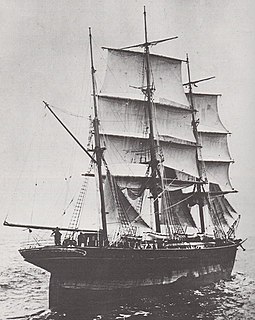 W
WLothair was a British clipper ship built by William Walker and launched in Rotherhithe, London, on 2 July 1870. After many years of service as a tea clipper, she was operated by merchants in Italy and Peru before being lost in 1910.
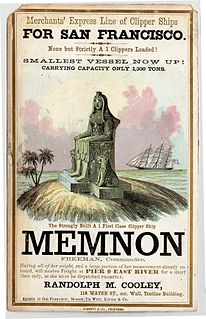 W
WThe Memnon was the first clipper ship to arrive in San Francisco after the Gold Rush, and the only clipper to arrive in San Francisco before 1850. Built in 1848, she made record passages to San Francisco and to China, and sailed in the first clipper race around Cape Horn.
 W
WMimosa was a clipper ship best known for carrying the first Welsh emigrants to South America in 1865.
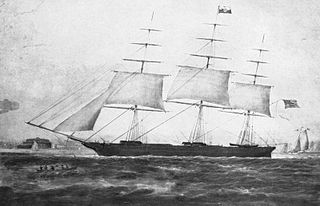 W
WUSS Nightingale (1851) was originally the tea clipper and slave ship Nightingale, launched in 1851. USS Saratoga captured her off Africa in 1861; the United States Navy then purchased her.
 W
WOsaka, A composite barque, built by William Pile, Sunderland, at Yard No. 179 for Killick Martin & Company, the company founded by Captain James Killick and launched on 12 July 1869. William Pile also built Osaka's sister ship Miako, for Killick Martin & Company launched on 15 April 1869.
 W
WIn the middle third of the 19th century, the clippers which carried cargoes of tea from China to Britain would compete in informal races to be first ship to dock in London with the new crop of each season. The Great Tea Race of 1866 was keenly followed in the press, with an extremely close finish. Taeping docked 28 minutes before Ariel - after a passage of more than 14,000 miles. Ariel had been ahead when the ships were taken in tow by steam tugs off Deal, but after waiting for the tide at Gravesend the deciding factor was the height of tide at which one could enter the different docks used by each ship. The third finisher, Serica, docked an hour and 15 minutes after Ariel. These three ships had left China on the same tide and arrived at London 99 days later to dock on the same tide. The next to arrive, 28 hours later, was Fiery Cross, followed, the next day, by Taitsing.
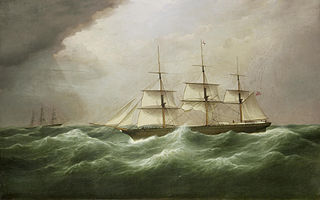 W
WRobin Hood was a tea clipper built by Alexander Hall and Sons, in Aberdeen, Scotland, in 1856. The ship's best known commander was Capt. Cobb. The ship is remembered for a 107-day passage to San Francisco.
 W
WSea Serpent was an 1850 extreme clipper that sailed in the San Francisco trade, the China trade, and the transatlantic lumber trade. She was one of the longest lived clippers, with a service life of 36 years and 5 months.
 W
WSea Witch was an American clipper ship designed by naval architect John W. Griffiths for the China trading firm of Howland & Aspinwall. She was launched at Smith & Dimon in Manhattan on December 8, 1846.
 W
WSir Lancelot was a clipper ship which sailed in the China trade and the India-Mauritius trade.
 W
WStag Hound was launched on December 7, 1850 in East Boston, Massachusetts. Designed by shipbuilder Donald McKay for the California trade, she was briefly the largest merchant ship in the world. She was in active service from 1851 until her total loss in 1861.
 W
WStornoway was a British tea clipper built by Alexander Hall and Sons in Aberdeen, Scotland in 1850. She was a further development by Hall on the clippers built in Aberdeen in 1848, being larger and more obviously suited to deep sea service. She was ordered by Jardine Matheson specifically for the tea trade. In the late 1840s, tea was available earlier in the season in China, so the first ships to load had to beat to windward against the north-east monsoon to get across the China Sea. The details of the hull shape designed by Hall had this requirement in mind.
 W
WSurprise was a California clipper built in East Boston in 1850. It initially rounded Cape Horn to California, but the vessel's owners, A. A. Low & Brother, soon found that the vessel performed well in Far Eastern waters. From that point onward the vessel spent much of her working life in the China trade, although the vessel also made three trips from the East Coast of the United States to California.
 W
WThermopylae was an extreme composite clipper ship built in 1868 by Walter Hood & Co of Aberdeen, to the design of Bernard Waymouth of London.
 W
WWitch of the Wave was a long-lived extreme clipper in the California trade, with a sailing life of over 34 years. In 1851, she sailed from Calcutta to Boston in 81 days, setting a record. It was renamed the Electra in 1871.
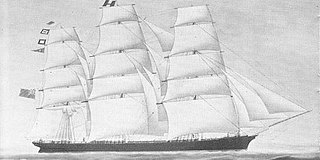 W
WWylo a composite clipper was built by Robert Steele & Company, Greenock, and launched on 15 April 1869. Robert Steele & Company also built the famous clippers Ariel and Taeping who took part in the great tea race of 1866, and Sir Lancelot another renown clipper ship.